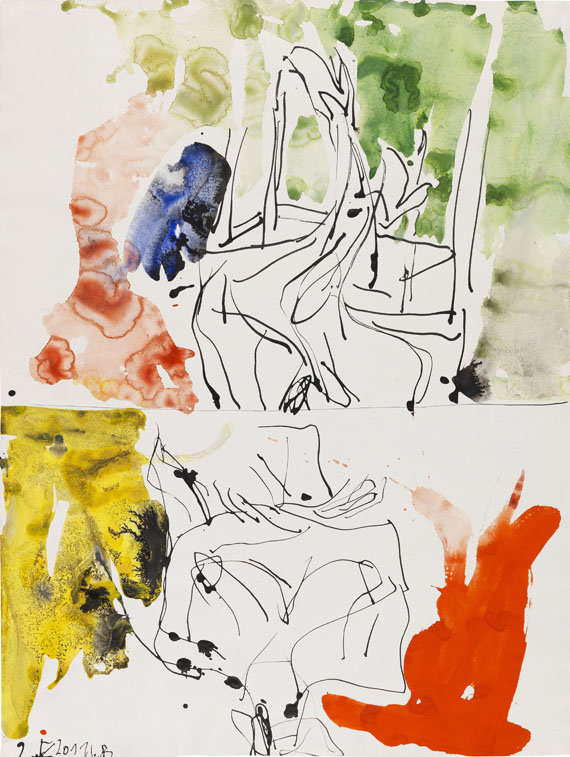198
Georg Baselitz
Zwei Kühe, 1968.
Watercolor and pastel chalks
Post auction sale: € 30,000 / $ 33,900
Zwei Kühe. 1968.
Watercolor and pastel chalks.
Signed and dated in the lower left. Signed, dated and titled on the reverse. On off-white laid paper. 35.1 x 50.1 cm (13.8 x 19.7 in), size of sheet. [JS].
• This work is from Baselitz's bold early body of work from the 1960s, which includes the famous “Hero” and “Fraktur” paintings.
• An exceptionally colorful work on paper, created in the context of Baselitz's rebellious “Fraktur” painting “Zwei halbe Kühe” (Two Half Cows, 1968).
• This work, as well as his first “upside-down” painting “Der Wald auf dem Kopf” from 1969), reveals progressive pictorial ideas that engage with art historical tradition.
• Baselitz attempts to disrupt the subject matter through his fragmented painting style and to confuse our traditional viewing habits as much as possible..
We are grateful to the Georg Baselitz Archive, Munich, for the kind expert advice. The work is registered in the archive of the artist's works.
PROVENANCE: Private collection, South Germany.
EXHIBITION: Siegfried Gnichwitz (ed.), Kunst geht in die Farbik. Dokumentation eines Experiments, Bonn-Bad Godesberg, Wissenschaftszentrum des Stifterverbandes für die Deutsche Wissenschaft, May-June 1987, p. 128 (illustrated).
"I love how art historians analyze Cranach, Correggio, and so on, but as a painter, I've never been particularly interested in that. I draw my inspiration from elsewhere, especially from the boldness exhibited by certain painters. The audacity to change images, to recreate them."
Georg Baselitz, quoted from: https://artinwords.de/wien-khm-georg-baselitz/
Watercolor and pastel chalks.
Signed and dated in the lower left. Signed, dated and titled on the reverse. On off-white laid paper. 35.1 x 50.1 cm (13.8 x 19.7 in), size of sheet. [JS].
• This work is from Baselitz's bold early body of work from the 1960s, which includes the famous “Hero” and “Fraktur” paintings.
• An exceptionally colorful work on paper, created in the context of Baselitz's rebellious “Fraktur” painting “Zwei halbe Kühe” (Two Half Cows, 1968).
• This work, as well as his first “upside-down” painting “Der Wald auf dem Kopf” from 1969), reveals progressive pictorial ideas that engage with art historical tradition.
• Baselitz attempts to disrupt the subject matter through his fragmented painting style and to confuse our traditional viewing habits as much as possible..
We are grateful to the Georg Baselitz Archive, Munich, for the kind expert advice. The work is registered in the archive of the artist's works.
PROVENANCE: Private collection, South Germany.
EXHIBITION: Siegfried Gnichwitz (ed.), Kunst geht in die Farbik. Dokumentation eines Experiments, Bonn-Bad Godesberg, Wissenschaftszentrum des Stifterverbandes für die Deutsche Wissenschaft, May-June 1987, p. 128 (illustrated).
"I love how art historians analyze Cranach, Correggio, and so on, but as a painter, I've never been particularly interested in that. I draw my inspiration from elsewhere, especially from the boldness exhibited by certain painters. The audacity to change images, to recreate them."
Georg Baselitz, quoted from: https://artinwords.de/wien-khm-georg-baselitz/
His outstanding artistic work, which has repeatedly found new creative ways to challenge and perpetuate art historical traditions since the 1960s, has made Georg Baselitz one of the most famous figures in contemporary German art. With his influential figurative works, he defies established categories and repeatedly challenges our traditional perception of art. In 1963, Baselitz rose to fame overnight with a significant controversy. His paintings “Die große Nacht im Eimer” (The Great Night in the Bucket, 1962) and “Der nackte Mann” (The Naked Man, 1962), shown in a solo exhibition at the Werner & Katz Gallery in Berlin, caused a major scandal. The latter depicts an emaciated male nude lying dead in a grave-like hole with an oversized penis. A shocking painting that alludes both to depictions of Christ's corpse and to images from Nazi concentration camps, which were ignored by large parts of German society after the war. Both paintings were confiscated by the public prosecutor's office on charges of pornography. The following day, the BZ newspaper wrote: “This is a scandal the likes of which Berlin has not seen since the end of the war.” In his famous “Hero” paintings (1965/66), in which Baselitz stages physically and emotionally broken figures, the rebellious artist confronts post-war German society just as relentlessly with its painful past. In the late 1960s, these antiheroes were followed by the “Fraktur” paintings (1966–1968), which also contain an inherent destructive element, as they visually dismantle the subject. Our colorful paper work was created in the context of the painting “Zwei halbe Kühe” (Two Half Cows, 1968), which Ketterer Kunst sold with great success from the same southern German private collection in 2017. With energetic strokes, Baselitz captured the two animals' shapes, which are partly broken down into contrasting areas of color. Shortly after this critical early creative phase, Baselitz produced his first upside-down painting, “Der Wald auf dem Kopf” (The Forest on the Head, Museum Ludwig, Cologne), in 1969. Once again, Baselitz radically challenged our traditional viewing habits. This step, which would become Baselitz's artistic trademark, was another powerful act of painterly liberation. “The act of painting itself emancipates itself from representation, from the pictorial, and at the same time allows the works to appear representational and non-representational.” (Toni Stoss, in: Georg Baselitz, Gemälde und Skulpturen 1960-2008, p. 8). [JS]
198
Georg Baselitz
Zwei Kühe, 1968.
Watercolor and pastel chalks
Post auction sale: € 30,000 / $ 33,900
Buyer's premium, taxation and resale right compensation for Georg Baselitz "Zwei Kühe"
This lot can be purchased subject to differential or regular taxation, artist‘s resale right compensation is due.
Differential taxation:
Hammer price up to 800,000 €: herefrom 32 % premium.
The share of the hammer price exceeding 800,000 € is subject to a premium of 27 % and is added to the premium of the share of the hammer price up to 800,000 €.
The share of the hammer price exceeding 4,000,000 € is subject to a premium of 22 % and is added to the premium of the share of the hammer price up to 4,000,000 €.
The buyer's premium contains VAT, however, it is not shown.
Regular taxation:
Hammer price up to 800,000 €: herefrom 27 % premium.
The share of the hammer price exceeding 800,000 € is subject to a premium of 21% and is added to the premium of the share of the hammer price up to 800,000 €.
The share of the hammer price exceeding 4,000,000 € is subject to a premium of 15% and is added to the premium of the share of the hammer price up to 4,000,000 €.
The statutory VAT of currently 7 % is levied to the sum of hammer price and premium.
We kindly ask you to notify us before invoicing if you wish to be subject to regular taxation.
Calculation of artist‘s resale right compensation:
For works by living artists, or by artists who died less than 70 years ago, a artist‘s resale right compensation is levied in accordance with Section 26 UrhG:
4 % of hammer price from 400.00 euros up to 50,000 euros,
another 3 % of the hammer price from 50,000.01 to 200,000 euros,
another 1 % for the part of the sales proceeds from 200,000.01 to 350,000 euros,
another 0.5 % for the part of the sale proceeds from 350,000.01 to 500,000 euros and
another 0.25 % of the hammer price over 500,000 euros.
The maximum total of the resale right fee is EUR 12,500.
The artist‘s resale right compensation is VAT-exempt.
Differential taxation:
Hammer price up to 800,000 €: herefrom 32 % premium.
The share of the hammer price exceeding 800,000 € is subject to a premium of 27 % and is added to the premium of the share of the hammer price up to 800,000 €.
The share of the hammer price exceeding 4,000,000 € is subject to a premium of 22 % and is added to the premium of the share of the hammer price up to 4,000,000 €.
The buyer's premium contains VAT, however, it is not shown.
Regular taxation:
Hammer price up to 800,000 €: herefrom 27 % premium.
The share of the hammer price exceeding 800,000 € is subject to a premium of 21% and is added to the premium of the share of the hammer price up to 800,000 €.
The share of the hammer price exceeding 4,000,000 € is subject to a premium of 15% and is added to the premium of the share of the hammer price up to 4,000,000 €.
The statutory VAT of currently 7 % is levied to the sum of hammer price and premium.
We kindly ask you to notify us before invoicing if you wish to be subject to regular taxation.
Calculation of artist‘s resale right compensation:
For works by living artists, or by artists who died less than 70 years ago, a artist‘s resale right compensation is levied in accordance with Section 26 UrhG:
4 % of hammer price from 400.00 euros up to 50,000 euros,
another 3 % of the hammer price from 50,000.01 to 200,000 euros,
another 1 % for the part of the sales proceeds from 200,000.01 to 350,000 euros,
another 0.5 % for the part of the sale proceeds from 350,000.01 to 500,000 euros and
another 0.25 % of the hammer price over 500,000 euros.
The maximum total of the resale right fee is EUR 12,500.
The artist‘s resale right compensation is VAT-exempt.
Headquarters
Joseph-Wild-Str. 18
81829 Munich
Phone: +49 89 55 244-0
Fax: +49 89 55 244-177
info@kettererkunst.de
Louisa von Saucken / Undine Schleifer
Holstenwall 5
20355 Hamburg
Phone: +49 40 37 49 61-0
Fax: +49 40 37 49 61-66
infohamburg@kettererkunst.de
Dr. Simone Wiechers / Nane Schlage
Fasanenstr. 70
10719 Berlin
Phone: +49 30 88 67 53-63
Fax: +49 30 88 67 56-43
infoberlin@kettererkunst.de
Cordula Lichtenberg
Gertrudenstraße 24-28
50667 Cologne
Phone: +49 221 510 908-15
infokoeln@kettererkunst.de
Hessen
Rhineland-Palatinate
Miriam Heß
Phone: +49 62 21 58 80-038
Fax: +49 62 21 58 80-595
infoheidelberg@kettererkunst.de
We will inform you in time.




 Lot 198
Lot 198 



